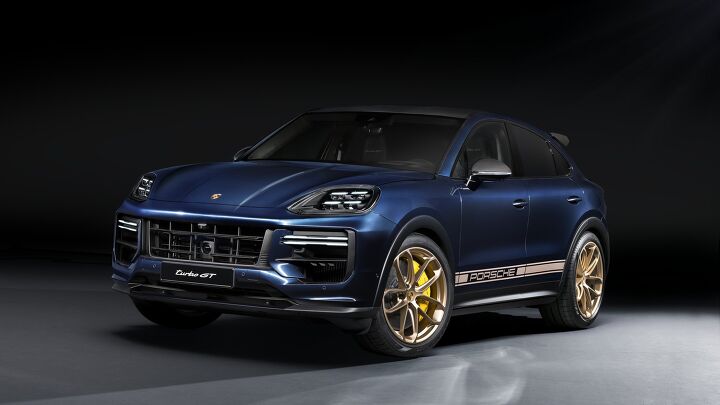2024 Porsche Cayenne Updates: More Power and More Screens

We could debate whether the Cayenne saved Porsche until the cows come home, but there’s no denying the SUV’s appeal and popularity in the automaker’s lineup. The SUV’s getting a refresh for 2024, but it’s not the mild facelift we often see in the industry. Porsche’s giving the Cayenne better powertrains, a revised interior with more screens, and upgraded suspension.
Porsche offers the 2024 Cayenne with three powertrains, starting with the entry-level turbocharged 3.0-liter V6, which makes 348 horsepower and 368 pound-feet of torque. The mid-range Cayenne S now gets a twin-turbo V8 with 468 horsepower and 442 pound-feet of torque, giving it a 4.4-second 0-60 mph time. The Turbo GT gets the twin-turbo V8 with power cranked up to 650 horsepower.
The Cayenne E-Hybrid is sticking around in 2024, and its new electric motor makes 174 horsepower, increasing output to 463. Range estimates for the plug-in Cayenne are on the way, but the battery capacity has been increased from 17.9 to 25.9 kWh. The Cayenne, Cayenne S, and E-Hybrid now come standard with Porsche Active Suspension Management (PASM), which features new shock absorbers. The system can be paired with optional adaptive air suspension, which responds to drive mode selection for better handling and performance.
Though the SUV looks roughly the same as before, Porsche said it touched nearly every exterior body panel, giving the Cayenne new fenders, an updated hood, and reshaped headlights. Three new colors are available, and buyers can add a Lightweight Sport Package that shaves 72 pounds from the hulking family hauler.
Changes to the cabin are impactful and include a shift from analog gauges to a completely digital experience. The SUV gets a 12.6-inch digital gauge cluster and a 12.3-inch center touchscreen. Porsche offers a 10.9-inch passenger display for the first time, which can stream video and other content. A special light filter ensures the driver isn’t distracted by the display.
Porsche installs more safety equipment as standard, including speed limit assist. The optional adaptive cruise control system now offers an evasive driving function and a turn assist function that can help avoid collisions in an intersection.
[Image: Porsche]
Become a TTAC insider. Get the latest news, features, TTAC takes, and everything else that gets to the truth about cars first by subscribing to our newsletter.

Chris grew up in, under, and around cars, but took the long way around to becoming an automotive writer. After a career in technology consulting and a trip through business school, Chris began writing about the automotive industry as a way to reconnect with his passion and get behind the wheel of a new car every week. He focuses on taking complex industry stories and making them digestible by any reader. Just don’t expect him to stay away from high-mileage Porsches.
More by Chris Teague
Latest Car Reviews
Read moreLatest Product Reviews
Read moreRecent Comments
- FreedMike Hint to Nissan: if you want something that will stand out in the market and be reasonably priced, how about a PHEV Frontier?
- FreedMike Apple Music through Carplay or Bluetooth. VWs also have a neat feature that allows you to scroll up and down through all available radio stations.
- FreedMike "Forced Neutral" - is that like the Sudetenland in 1938? Seriously, Ford...WTF.
- Wjtinfwb I foresee HUGE rebates on this. The "quasi-Safari" look on 911s is one think on a 150k plaything. It's another when slapped on a 40k EV with a 20k premium.
- Wjtinfwb 100k. What happened to the 40k version I reserved back a year + ago? Regardless, since you could by a new Silverado Trail Boss V8 for 60k and put the remaining 40k in a Money Market at 4-5%, why would anyone spend the extra $$$? And please don't make it about the environment. Moving a 3 ton truck through the air is going to take a lot of energy and energy doesn't fall out of trees. Whether Solar, Wind, Nuclear or Mermaid farts, there's a financial and environmental impact. Why not go with the least expensive impact?

































Comments
Join the conversation
Coming soon to a neighborhood brothel near you!
Looks like the BMW grille man has been around...